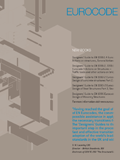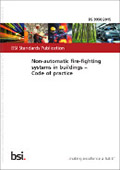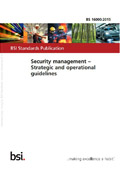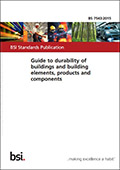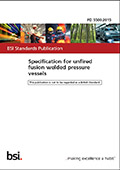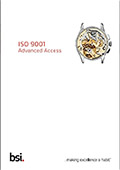
BSI é o Organismo responsável pela Normalização no Reino Unido produzindo normas e produtos de informação para promover e compartilhar as melhores práticas. Ela serve os interesses de uma ampla gama de setores da indústria, bem como governos, consumidores, funcionários e sociedade em geral para se certificar que as normas britânicas, européias e internacionais são úteis, relevantes e de autoridade.
A BSI produz normas e publicações que são de interesse de uma ampla gama de setores da indústria, bem como governos, consumidores, funcionários e sociedade em geral. Segue abaixo uma pequena relação de normas/livros da entidade. Caso queira consultar normas da BSI sobre outro assunto favor clicar em Pesquisa no menu acima. Possuímos em nossos registros, atualizados sistematicamente,informações sobre todas as normas da BSI que estão vigentes.
Os EUROCODES são vistos como o principal caminho em Códigos Estruturais. Sua flexibilidade permite a utilização não somente na Europa mas em todo o mundo. Vários países fora da Europa, inclusive o Brasil, estão comprometidos em adotá-los.
Alguns dos principais objetivos dos EUROCODES:- Fornecer os critérios de projeto e métodos comuns para cumprir os requisitos necessários de resistência mecânica, estabilidade e resistência ao fogo, incluindo aspectos de durabilidade e economia.
- Fornecer um entendimento comum em relação ao projeto de estruturas entre os proprietários, operadores e usuários, designers, empreiteiros e fabricantes de produtos de construção
- Facilitar a comercialização e utilização de componentes estruturais e kits dentro dos Estados-Membros da UE
- Facilitar a comercialização e a utilização de materiais e produtos constituintes, as propriedades daqueles envolvidos em cálculos do projeto
- Ser uma base comum para pesquisa e desenvolvimento na indústria da construção
- Permitir a elaboração de projeto comum de ajuda e software
- Aumentar a competitividade das empresas européias de engenharia civil, empreiteiros, projetistas e fabricantes de produtos em suas atividades globais.
- BS EN 1990:2002 Eurocode. Basis of structural design
- National Annex to BS EN 1990:2002 - Essential to use with BS EN 1990
- PP 1990:2004 - Guide to the structural Eurocodes for students of structural design
- BS EN 1991-1-1:2002 General actions. Densities, self-weight, imposed loads for buildings
- BS EN 1991-1-2:2002 General actions. Actions on structures exposed to fire
- BS EN 1991-1-3:2003 General actions. Snow loads
- BS EN 1991-1-4:2005 General actions. Wind actions
- BS EN 1991-1-5:2003 General actions. Thermal actions
- BS EN 1991-1-6:2005 General actions. Actions during execution
- BS EN 1991-1-7:2006 General actions. Accidental actions
- BS EN 1991-2:2003 Traffic loads on bridges
- BS EN 1991-3:2006 Actions induced by cranes and machines
- BS EN 1991-4:2006 Silos and tanks
- PD 6688-1-2 Background paper to the UK national Annex to BS EN 1991-1-2
- PD 6688-1-4 Background information to the National Annex to BS EN 1991-1-4 and additional guidance
- PD 6688-1-7 Background paper to the UK National Annex to BS EN 1991-1-7
- PD 6688-2 Proposed title: Recommendations for the design of structures to BS EN 1991-2
- BS EN 1992-1-1:2004 General rules and rules for buildings
- BS EN 1992-1-2:2004 General rules. Structural fire design
- BS EN 1992-2:2005 Concrete bridges. Design and detailing rules
- BS EN 1992-3:2006 Liquid retaining and containing structures
- PD 6687:2006 Background paper to the UK National Annexes to BS EN 1992-1
- PD 6687-2:2008 Recommendations for the design of structures to BS EN 1992-2:2005
** Execution documents- BS EN 13670:2009 Execution of concrete structures **
- BS EN 1993-1-1:2005 General rules and rules for buildings
- BS EN 1993-1-2:2005 General rules. Structural fire design
- BS EN 1993-1-3:2006 General rules. Supplementary rules for cold-formed members and sheeting
- BS EN 1993-1-4:2006 General rules. Supplementary rules for stainless steels
- BS EN 1993-1-5:2006 Plated structural elements
- BS EN 1993-1-6:2007 Strength and stability of shell structures
- BS EN 1993-1-7:2007 Plated structures subject to out of plane loading
- BS EN 1993-1-8:2005 Design of joints
- BS EN 1993-1-9:2005 Fatigue
- BS EN 1993-1-10:2005 Material toughness and through-thickness properties
- BS EN 1993-1-11:2006 Design of structures with tension components
- BS EN 1993-1-12:2007 Additional rules for the extension of EN 1993 up to steel grades S 700
- BS EN 1993-2:2006 Steel bridges
- BS EN 1993-3-1:2006 Towers, masts and chimneys. Towers and masts
- BS EN 1993-3-2:2006 Towers, masts and chimneys. Chimneys
- BS EN 1993-4-1:2007 Silos
- BS EN 1993-4-2:2007 Tanks
- BS EN 1993-4-3:2007 Pipelines
- BS EN 1993-5:2007 Piling
- BS EN 1993-6:2007 Crane supporting structures
- PD 6695-1-9:2008 Recommendations for the design of structures to BS EN 1993-1-9
- PD 6695-1-10:2009 Recommendations for the design of structures to BS EN 1993-1-10
- PD 6695-2 Recommendations for the design of bridges to BS EN 19932:2006
Execution documents:
- BS EN 1090-1:2009 Execution of steel structures and aluminium structures. Requirements for conformity assessment of structural components
- BS EN 1090-2:2008 – Execution of steel structures and aluminium structures - Part 2: Technical requirements for steel structures
- BS EN 1090-3:2008 – Execution of steel structures and aluminium structures - Part 3: Technical requirements for aluminium structures
- BS EN 1994-1-1:2004 General rules and rules for buildings
- BS EN 1994-1-2:2005 General rules. Structural fire design
- BS EN 1994-2:2005 General rules and rules for bridges
- PD 6696-2:2007 Background paper to BS EN 1994-2 and the UK National Annex to BS EN 1994-2.
- BS EN 1995-1-1:2004 Common rules and rules for buildings
- BS EN 1995-1-2:2004 General. Structural fire design
- BS EN 1995-2:2004 Bridges
- BS EN 1996-1-1:2005 General rules for reinforced and unreinforced masonry structures
- BS EN 1996-1-2:2005 General rules. Structural fire design
- BS EN 1996-2:2006 Design considerations, selection of materials and execution of masonry
- BS EN 1996-3:2006 Simplified calculation methods and simple rules for masonry structures
- PD 6697 Recommendations for the design of masonry structures to BS EN 1996-1-1 a nd BS EN 1996-2
- BS EN 1997-1:2004 General rules
- BS EN 1997-2:2007 Ground investigation and testing
Execution documents:
- BS EN 1536:2000 Execution of special geotechnical works. Bored piles
- BS EN 1537:2000 Execution of special geotechnical works. Ground anchors
- BS EN 1538:2000 Execution of special geotechnical works. Diaphragm walls
- BS EN 12063:1999 Execution of special geotechnical work. Sheet pile walls
- BS EN 12699:2001 Execution of special geotechnical work. Displacement piles
- BS EN 12715:2000 Execution of special geotechnical work. Grouting
- BS EN 12716:2001 Execution of special geotechnical works. Jet grouting
- BS EN 14199:2005 Execution of special geotechnical works. Micropiles
- BS EN 14475:2006 Execution of special geotechnical works. Reinforced fill
- BS EN 14679:2005 Execution of special geotechnical works. Deep mixing
- BS EN 14731:2005 Execution of special geotechnical works. Group treatment by deep vibration
- BS EN 15237:2007 Execution of special geotechnical works. Vertical drainage
- BS EN 1998-1:2004 General rules, seismic actions and rules for buildings
- BS EN 1998-2:2005 Bridges
- BS EN 1998-3:2005 Assessment and retrofitting of buildings
- BS EN 1998-4:2006 Silos, tanks and pipelines
- BS EN 1998-5:2004 Foundations, retaining structures and geotechnical aspects
- BS EN 1998-6:2005 Towers, masts and chimneys
- PD 6698 Recommendations for the design of structures for earthquake
- BS EN 1999-1-1:2007 General structural rules
- BS EN 1999-1-2:2007 Structural fire design
- BS EN 1999-1-3:2007 Structures susceptible to fatigue
- BS EN 1999-1-4:2007 Cold-formed structural sheeting
- BS EN 1999-1-5:2007 Shell structures
- PD 6702-1:2009 Structural use of aluminium. Recommendations for the design of aluminium structures to BS EN 1999
- PD 6705-3:2009 Structural use of steel and aluminium. Recommendations for the execution of aluminium structures to BS EN 1090-3
Execution documents:
- BS EN 1090-1:2009 Execution of steel structures and aluminium structures. Requirements for conformity assessment of structural components
- BS EN 1090-2:2008 – Execution of steel structures and aluminium structures - Part 2: Technical requirements for steel structures
- BS EN 1090-3:2008 – Execution of steel structures and aluminium structures - Part 3: Technical requirements for aluminium structures
Além disso oferece consultoria especializada sobre a interpretação e aplicação dos códigos, bem como capacidade de manipular os documentos para torná-los uma ferramenta funcional para o projeto em vez de simplesmente ser um documento de referência. Os documentos podem ser vistos lado a lado, notas podem ser adicionadas e compartilhadas entre os colegas e você pode construir seus próprios documentos dinâmicos para ilustrar o fluxo de trabalho entre os documentos para aumentar a eficiência e garantir que todos tenham acesso à informação correta. Para maiores informações favor entrar em contato.

| Publication date 2015-01 | |
BS 9990:2015 Non automatic fire-fighting systems in buildings. Code of practice |
| Publication date 2015-06 | |
BS 16000 Security management - Strategic and operational guidelines |
| Publication date 2015-04 | |
BS 7543:2015 Guide to durability of buildings and building elements, products and components. |
| Publication date 2015-04 | |
Specification for unfired fusion welded pressure vessels |
| Publication date 2015-07 | |
With more than a million organizations certified to ISO 9001, it is the most widely recognized standard in the world. It sets out requirements for quality management systems, and is suitable for all types of organizations.
|
